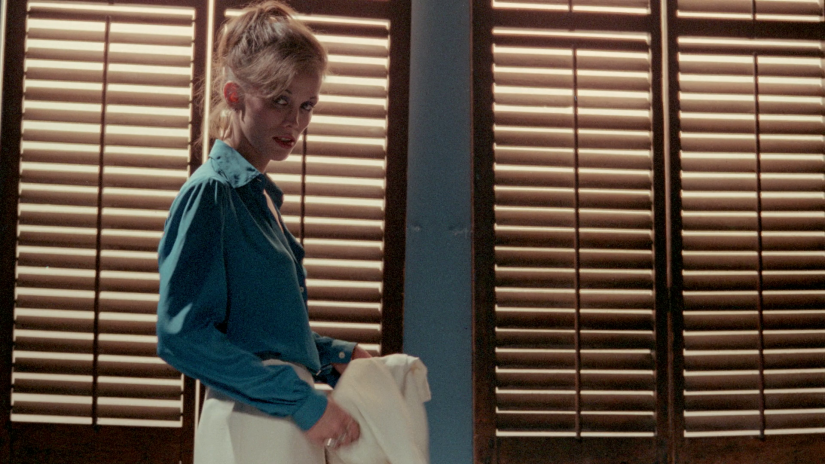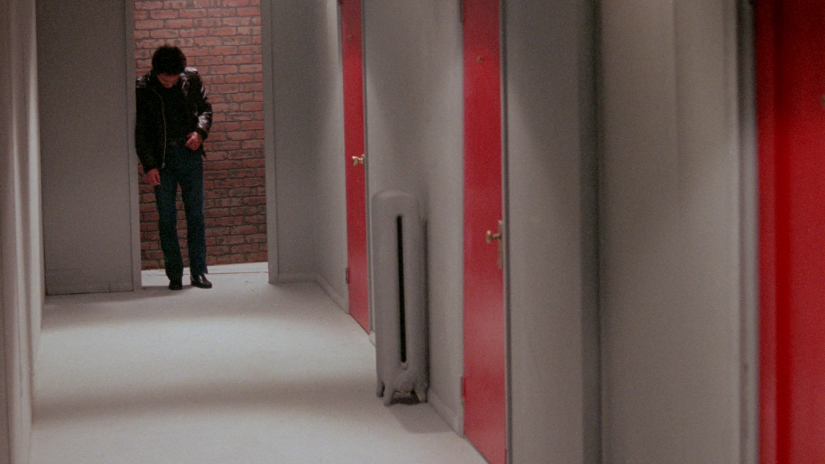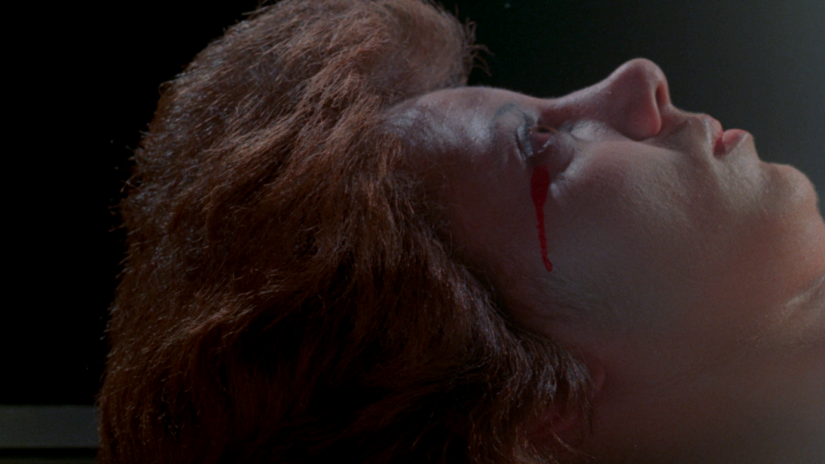Part one can be read here.
Despite the linear path of Alan’s colorized sex odyssey, Alan inexplicably emerges out of the same door he entered, only to find that The Woman Behind the Desk has been replaced by a single briefcase. Or did she simply leave it there? This unsettling sight signals a quid pro quo. After Alan was able to make his trio of denouncements, he not only leaves a changed man, but with a new lease on life and sex.
The film then abruptly shifts back to the actual protagonist, as we find Williams and his wife returning home after the opening business scene. Williams is quick to remind his wife Doreen (Tiffany Clark) that it wasn’t a negotiation, it was an ultimatum. This correction highlights the discordance that Alan felt inside the three rooms, specifically with the Girl in Black. When Alan was close to ejaculation, the Girl in Black angrily demands him to not come inside her. Alan was forced to sever the connection at the last minute for an unflattering finish. A whimper at the end of a bang. While cum shots are a staple of the genre, they rarely look as pathetic and cold-blooded as Alan’s. This forced separation of bodies and engagement highlights the emptiness of this mating ritual. He went in thinking it was a negotiation, he left knowing he had no say in the matter.
Williams and his wife have sex, in what can be described as the film’s only scene of padding (in fact, the character of Doreen is superfluous at best, with all due respect to Tiffany Clark). Williams point out that “love” and business do not mix, which is strange because he also seems to see his own marriage as a sort of business. He refers to his devotion to his wife in transactional terms. “You give me everything I want,” she reminds him.

“You don’t want anything,” he points out. Fucking ensues.
After they make love, Williams mentions that he has to go see some people. What follows is a striking montage set to Adagio in D Minor, composed by Tomaso Albinoni (a classical piece that has been everywhere from standing in as the main theme for Resnais’ Last Year at Marienbad to acting as the despairing accompaniment of last year’s great Manchester by the Sea climatic centerpiece that dealt with its protagonist’s tragic backstory). The montage works primarily because of its weird uneasiness. We see shots of statues and commuters at Grand Central terminal, all set to the haunting Albinoni piece, but what makes it otherworldly is the way the montage is bookended by shots of Williams approaching/looking out of his blinds, and of him solemnly walking away from them. The suggestion that these images are what he’s seeing outside his own window create a cognitive dissonance between the several layers of voyeurism. All which work on their own, but taken together they create an impossible moment to understand from a grounded perspective.
Williams makes his way to a dive bar with a little slice of paradise. Paradise in the form of a stripper basking in the glow of a soft spotlight and a perpetual air of fog. Her dancing is quite stationary and has little regard for the man leering at her. The man being Williams brother Larry (Bobby Astyr, in what’s easily the standout performance in the film, fiercely committed to his own sleaze). It seems Alan has failed to deliver what Williams sent him out to get, and Larry is in a position to help. After quipping about their strained relations (Williams is all too ready to point out they’re only half brothers) and the mysteries of the male libido, the two descend into the bar’s cellar. It’s here the audience is clued into the fact that the image of Williams descending into the cellar during the title card of the film, is chronologically the midpoint of the story. The sense of Deja Vu is palpable and only strengthens the film’s elliptical atmosphere.
Down in the “underworld,” let’s call it, as it is clearly not just a basement, but a stand in for some kind of realm that exists geographically and morally underneath the high ground of the rest of the world, Williams finds himself facing something not unlike the trial of rooms Alan faced before him.

Larry says they have time to kill before getting to where they’re going, and so he suggests Williams might as well peep on the happenings in each of the three rooms. These trio of rooms, none of which Williams is allowed to enter, act less as a trial for Williams, and more as a reminder of his lack of agency in this whole situation. In the first room, the peephole merely reveals some sudsy showering lesbian erotica, clearly being performed for anyone looking through the peephole. Williams is distracted, but hardly amused. Upon looking through the second peephole, the foundation of Williams’ perception of reality begins to crumble.

The second room is home to a heterosexual S&M couple. The woman is dominating the masked man and subjecting him to a series of ridicule and dehumanizing gestures. It’s not until she rips off the man’s mask, that Williams is able to see that the man is none other than himself. Williams is disturbed and outraged, asking his brother what the meaning of this is. The meaning may be lost on Williams, but not on the viewers. Williams is experiencing something we all experience (whether we’re conscious of it or not). When watching pornography or participating in sexual acts, we often try to pull on the thread that connects where we derive pleasure from and the ultimate “meaning” behind this desire. Rather than accept our own sexuality for what it is, most people can’t help but to investigate. While this can be a useful cause in some respects, more often than not, it is merely in service of pleasing others, and not ourselves. This inability to reconcile what we’re watching/partaking in, and observing it from a coveted objective perspective can drive us crazy, as it does Williams. His half-brother Larry, an arbiter of sorts, simply laughs it off and even suggests that it’s impossible for Williams to be in two places at once. Anyone that’s ever participated in a sexual act of any kind can see the ridiculousness of this, as there is a very common divide between body and mind.
The third door is the most disturbing visualization. Through the peephole, Williams is able to see the man he sent to collect his briefcase, virtually unrecognizable with a newly made up face, and a corpse for him to pervertedly defile. It’s an interesting choice to pair the one room that has any bearing on plot with the one display of necrophilia. Despite the sinister undertones and morally reprehensible act, there’s something quite beautiful about the way Watkins presents it. The room is bathed in white, which extends itself from the walls to the make up on Alan’s face (which brings to mind a mime’s face, which is ironic, as sex with a dead person is… well, kind of a sick extension of what it would look like if someone was miming sex… ie. going through the motions. But Watkins’ sympathy for his characters does not stop with the living. As Alan engages in his act of defiling his angelic corpse, a close-up settles on the dead woman’s face. A single tear of blood falls from her eye.

In writing, this scene may seem like an obligatory escalation in the film’s nightmarish journey, but it plays out more as a confirmation of what Alan learned to do in his set of three rooms at the beginning. After denouncing everything, we’re now shown his reward: sex with a corpse (and not the kind of corpse from Jörg Buttgereit’s Nekromantik, the next film I’m writing about on this site). The corpse is practically laid out like a reward, a reward presented to him from a seemingly angelic place. Alan revels in both his lifeless partner and the fact that someone else is forced to watch him. Clearly the balance of power has shifted from Williams to Alan, from employer to employee. Far from a gross-out scene, Watkins’ depiction of necrophilia here is sinister, yet graceful. The duality here is stunning and compelling, and Williams starts to beat down the door in an attempt to stop Alan. Because anybody on the outside looking in on that practice will be justifiably outraged.

Williams and Larry proceed to meet with Alan after he finishes up. The business meeting is lit in a green glow (not so subtly reinforcing that everyone there is only meeting for one primal reason: wealth and power, as if somebody switched out Pulp Fiction‘s briefcase glow with one of a more envious shade of green). This meeting sends the film hurtling towards its conclusion. All of the disparate threads come together (albeit, not in the most cohesive way, but hey, dream logic and all that). At some point Williams even finds time to meet with his go-to prostitute (hello Vanessa del Rio) named Erda (so I guess she brings him back down to Earth).
Corruption is not shy about assigning its spaces varying quantum properties and letting its abstract atmosphere speak for itself. Clearly these rooms mean something, and that meaning can change with any given person, and what they see when they’re looking in. This is why Roger Watkins’ film lends itself to such wonderful repeat viewings. It never feels like we’re watching the same film twice. If you haven’t even seen it once, what are you waiting for? It’s waiting for you. Open the door.



